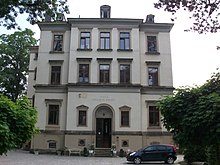Gückelsberg
|
Gückelsberg
City of Flöha
Coordinates: 50 ° 51 ′ 41 ″ N , 13 ° 4 ′ 54 ″ E
|
||
|---|---|---|
| Residents : | 710 (1910) | |
| Incorporation : | April 1, 1920 | |
| Incorporated into: | Flea | |
| Postal code : | 09557 | |
| Area code : | 03726 | |
|
Location of Gückelsberg in Saxony |
||
Gückelsberg is part of the municipality of the large district town of Flöha in the Saxon district of Central Saxony . The place was incorporated on April 1, 1920.
geography
Gückelsberg is located on the northwestern edge of the lower Eastern Ore Mountains in the northeast of the city of Flöha. The federal road 173 runs through the district to Freiberg. Gückelsberg is bounded in the south by the lower reaches of the Flöha . Its confluence with the Zschopau is just a little further west in the district of Flöha .
Neighboring towns of Gückelsberg are Flöha in the south and west, Hausdorf in the north and Falkenau in the east.
history
Foundation and place name
Gückelsberg was founded in the second half of the 12th century as a one-sided Waldhufendorf . It was first mentioned in a document in 1365. At that time, Guckilberg was written, 1367 Juckelsberg. Other spellings appearing in documents are Gögkelßberge (1522), Jogkelßperg (1524), Gückelsberg (1528), Kuckelsberg (1540) and Gickelsperg. The different spellings of the place name make it difficult to recognize the original meaning of the name. Obvious is the Middle High German word gugel (e) , in the Latin language cucula . The word means hood , it was also used as a field name meaning mountain (or ridge) with a hood-like forest . But it could also be based on the meaning of fool , just as gouch - cuckoo , but also Gockel, Gickel in the meaning of cock, hen and gogel - joke, gugelaere - juggler, buffoon cannot be excluded. Finally, one must also think of Jogel, Jockel, Jöckel as the form of the nickname Jakob .
Manorial and administration
From 1551 Gückelsberg belonged to the office of Schellenberg as an official village . The administration of Gückelsberg, whose lordship lay with the Lichtenwalde manor , was transferred to the new Lichtenwalde office in 1562 . With this the place belonged to the Amt Frankenberg-Sachsenburg around 1696 and to the Amt Augustusburg around 1794 . Due to the Saxon rural community code of 1838 , a community council was elected by the villagers for the first time in Gückelsberg in 1839. In 1856 the jurisdiction of the place was transferred to the court office of Augustusburg . Since 1875 Gückelsberg has belonged to the newly founded Amtshauptmannschaft Flöha .
On April 1, 1920 Gückelsberg became part of the village of Flöha. The last Gückelsberg municipal office was at Dresdner Strasse 49. In 1933, Flöha was granted town charter, which made Gückelsberg a district. As a district of Flöhas, Gückelsberg belonged to the Flöha district in the Chemnitz district from 1952 (renamed the Karl-Marx-Stadt district in 1953 ) and from 1990 to the Flöha district in Saxony . With this, the place came to the Freiberg district in 1994 and to the central Saxony district in 2008 .
Church and school
Gückelsberg is parish after Flöha, belongs to the Evangelical Lutheran parish of St. Georgen in Flöha. In 1832 Gückelsberg received the first school after having previously attended the church school in Flöha.
Industry in the village
In the 19th century, water power began to be used for new businesses. Here in the region around Flöha it was mainly companies in the textile industry . A spinning mill was opened in Gückelsberg in 1830 . This started industrialization in Gückelsberg and, as a result, an almost exponential growth in the population and a corresponding large number of children, which made it possible to have its own village school.
After the Second World War , large companies were expropriated without compensation in 1946. In Gückelsberg this affected u. a. the "cotton spinning mill Gückelsberg Schulz AG", which was later converted into a state or state-owned company.
Development of the population
|
|
traffic
The federal highway 173 leads through the village from Chemnitz to Freiberg . The closest train station is the Flöha train station on the Dresden – Werdau line (part of the Saxony-Franconia Magistrale ).
Web links
- Gückelsberg in the Digital Historical Directory of Saxony
- History of Flöha and its districts on the homepage of the city of Flöha
Individual evidence
- ↑ Gückelsberg in the Historical Directory of Saxony , accessed on June 18, 2014
- ↑ Karlheinz Blaschke (Ed.): Historical local directory of Saxony , new edition, Leipzig 2006, p. 295, ISBN 3-937209-15-8
- ↑ Ernst Eichler , Hans Walther (ed.): Historisches Ortnamesbuch von Sachsen , Berlin 2001, Volume I, pp. 374, 373, ISBN 3-05-003728-8
- ^ Karlheinz Blaschke , Uwe Ulrich Jäschke : Kursächsischer Ämteratlas. Leipzig 2009, ISBN 978-3-937386-14-0 ; P. 70 f.
- ^ The Flöha district administration in the municipal register 1900
- ↑ The parish of St. Georgen on the homepage of the city of Flöha ( Memento of the original from July 26, 2014 in the Internet Archive ) Info: The archive link was automatically inserted and not yet checked. Please check the original and archive link according to the instructions and then remove this notice.
- ↑ name = "HOV"



